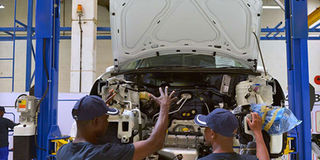Surest way to high-income economy

Technicians work on a new Polo Vivo at the newly-opened assembly plant in Thika, Kiambu County, on December 21, 2016. Manufacturing guarantees increasing returns to scale. PHOTO | TONY KARUMBA | AFP
What you need to know:
- Weak multiplicity and duplication in institutional set-up could continue to be a huge constraint to the achievement of our economic development objectives.
- Countries that have transitioned to high middle-income or high-income economic status strongly focused on creating strong economic institutions.
Kenya’s socioeconomic development has come of age with the country’s transformation from low-income to lower middle-income economic status.
Though not a sufficient measure of economic progress, income remains the global yardstick for countries’ economic transformation.
In his award-winning book Development as Freedom, Nobel laureate Amartya Kumar Sen, a leading Indian economist, views development as a package of freedoms such as political ones, opportunities for self-development and economic protection from abject poverty.
To deal with ‘unfreedoms’, the citizen should be empowered by creation of socioeconomic and political opportunities for sustainable livelihoods.
The human development index (HDI), used by the UN as the composite measure of economic prosperity by nations, focuses on three aspects of life, all put together: longevity in life, gross national income (GNI) and literacy.
PURCHASING POWER
Kenya has recorded significant progress in this regard with the introduction of, in part, free primary education, free healthcare, mobile money transfers, social protection of the elderly through cash transfers, and improvement of the ease of doing business where it was 56th in 2019.
The HDI rates Kenya at 0.579, which is an average score between zero and one with one as the highest.
The income component contributor to the score rates Kenya’s GNI at slightly above $3,000 (Ksh302,820) in 2018 using purchasing parity terms, an equalisation of a basket of goods to $1 in a country.
That reflects the economic capability of citizen in access to basic commodities, what Kenyans refer to when they talk about “hard economic times” when the reach of such basic needs as food, shelter and healthcare becomes hard due to low purchasing power.
This explains why the focus since 2017 has been implementation of President Kenyatta’s Big Four Agenda.
INDUSTRIES
Successful implementation of the "Economic Recovery Strategy for Wealth and Employment Creation" (2003-2007) — the so-called “Emilio Kibaki effect” — ushered a long-term economic blueprint, the Kenya Vision 2030, which has so far yielded high economic progress and sociopolitical development.
The Big Four seek to embolden and speed up the realisation of the long-term economic blueprint. Its successful implementation will see the country’s change agenda achieved.
Countries that have transitioned to high middle-income or high-income economic status, or high HDI status, strongly focused on creating strong economic institutions, which create a conducive platform for the citizen to contribute more to nation-building.
Making a transition from raw to value-added productive capacity would be key to the Big Four success.
Manufacturing guarantees increasing returns to scale through high-value jobs creation, value addition and expansion.
Trading in raw materials has primitivising effects on the economy — like reduced innovation, low job creation and increased poverty due to its decreasing returns-to-scale.
INSTITUTIONAL FRAMEWORK
Weak multiplicity and duplication in institutional set-up could continue to be a huge constraint to the achievement of our economic development objectives.
Therefore, the government has initiated mergers to rationalise and enhance the productivity of government-owned enterprises (GOEs).
The Ministry of Industry, Trade and Cooperatives should, therefore, be supported in speeding up the rationalisation of state agencies in line with the report of the Presidential Taskforce on Parastatal Reforms of 2013. This remains one of the biggest enablers to the Big Four.
The proposed mergers would, among other things, guarantee a strong economic institutional framework that could spur high economic development that lifts majority of Kenyans out of abject poverty.
We can emulate countries such as Malaysia, France, Japan, Korea and Rwanda, China — their different economic models notwithstanding — in coining institutional frameworks that support creation of jobs and wealth and establish strong partnerships globally to net the most foreign exchange.
TAKE UP REFORMS
The biggest deterrent to such reforms, however, is the fear of disruption of comfort zones, business-as-usual mentality and panic over loss of executive jobs that exist at the expense of national economic development interests.
With the parastatal reforms, Kenya’s economic objectives will be achieved.
This is how patriots and heroes are created in contemporary Kenya: paying the price today to create the Kenya we want — a prosperous Kenya, by all Kenyans, for all Kenyans.
Mr Biwott, a development economist, is the CEO, Kenya Export Promotion and Branding Agency (Keproba). [email protected].





